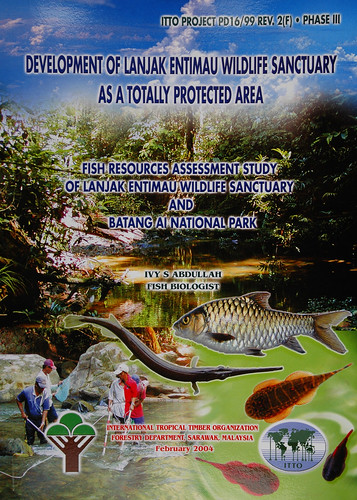
This is a well illustrated medium sized volume covering the freshwater fishes of the catchment area of the Lanjak Entimau Wildlife Sanctuary (Rejang basin) and Batang Ai NationalPark (Lupar basin).
This publication covers mainly the fish diversity, recommendations for conservation and possible applications in aquaculture and aquarium trade. The fish list draws from several earlier unpublished reports and substantiates the findings with more records and lists possible new species.
The maps provided are very detailed contour maps of poor resolution. Simpler line drawing maps would have been sufficient.
Several tables are provided listing the fish obtained from the abovementioned areas. Table 2 provides a fish list from Lanjak Entimau Wildlife Sanctuary, of which several species are of questionable identities; as follows:
Gastromyzon contractus – as from illustrations from plate 25, it is G. fasciatus;
Gastromyzon ridens – from current understanding (and unpublished data), it is restricted to the Kapuas basin;
All three species of Glaniopsis – from current understanding (and unpublished data), they are all restricted to their respective type localities and basins.
However, these cannot be confirmed till the actual specimens are examined.
Table 4 provides a fish list from Batang Ai National Park, of which several species are of questionable identities; as follows:
Akysis baramensis – this is a rather southern distribution from the type locality, more detailed examination required to clarify the identity;
Gastromyzon borneensis - from current understanding (and unpublished data), it is restricted to western Sabah;
Gastromyzon ridens – from current understanding (and unpublished data), it is restricted to the Kapuas basin;
All three species of Glaniopsis – from current understanding (and unpublished data), they are all restricted to their respective type localities and basins.
However, these cannot be confirmed till the actual specimens are examined.
At least one reference is missing, e.g. Roberts, 1980, in which the year could be wrongly quoted. This publication suffers from outdated taxonomical names and identifications, as follows:
Plate 3 – should be Puntius banksi juvenile
Plate 5 – should be Lobocheilos sp.
Plate 6 – should be Osteochilus sarawakensis
Plate 10 – should be Auriglobus nefastus
Plate 13 – should be Rasbora agyrotaenia
Plate 15 – should be Rasbora caudimaculata
Plate 18 – should be Glyptothorax major
Plate 20 – should be Clarias leiacanthus
Plate 21 – should be Barbonymus collingwoodi
Plate 24 – should be Schismatorhynchos holorhynchos
Plate 25 – should be Gastromyzon fasciatus
Plate 33 – should be Homaloptera nebulosa
Plate 35 – should be Nemacheilus saravacensis
Plate 36 – should be Neogastromyzon cf. pauciradiatus
Plate 37 – should be Leiocassis poecilopterus
Plate 38 – should be Pseudomystus rugosus
Plate 45 – should be Macrognathus circumcinctus
Plate 47 – should be Schismatorhynchos holorhynchos
This publication also lists good recommendations for the conservation of the areas mentioned. Also providing avenues for local people’s involvement through aquaculture of local fish species, e.g. Tor spp.
Despite these shortcomings, this is a timely publication to illustrate the real state of knowledge we have of the tropical biodiversity in Southeast Asia. It is a commendable effort for the author to publish this despite restricted access to updated publications and taxonomical help.
Tan Heok Hui
Department of Biological Sciences
National University of Singapore
Kent Ridge 119260
Republic of Singapore
First published in The Raffles Bulletin of Zoology Vol. 54(1): 201-202 on 28 Feb 2006.
